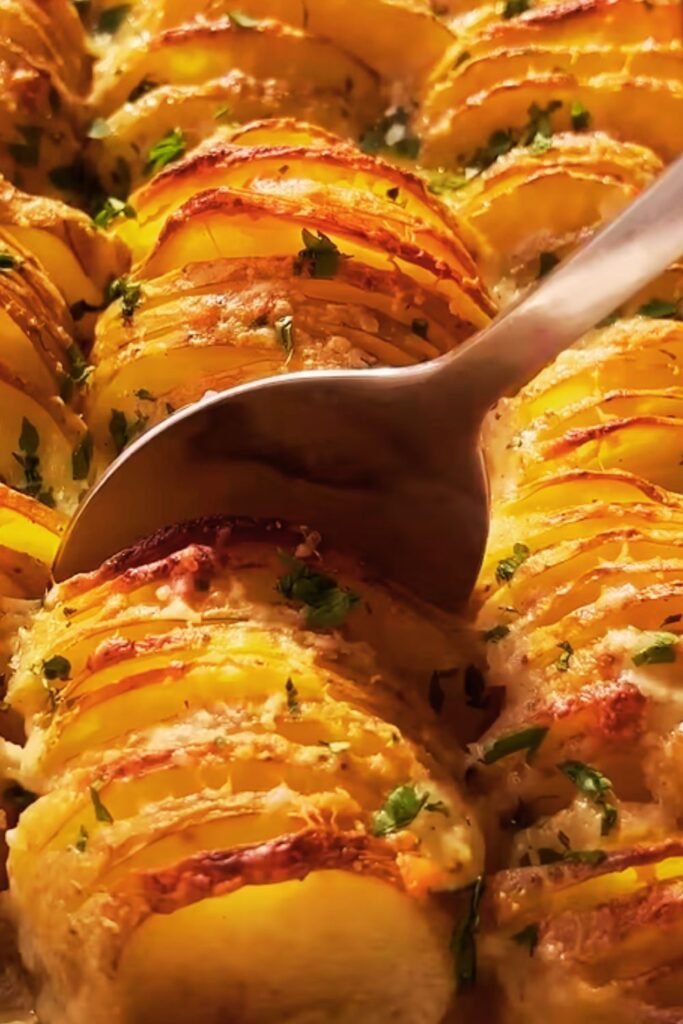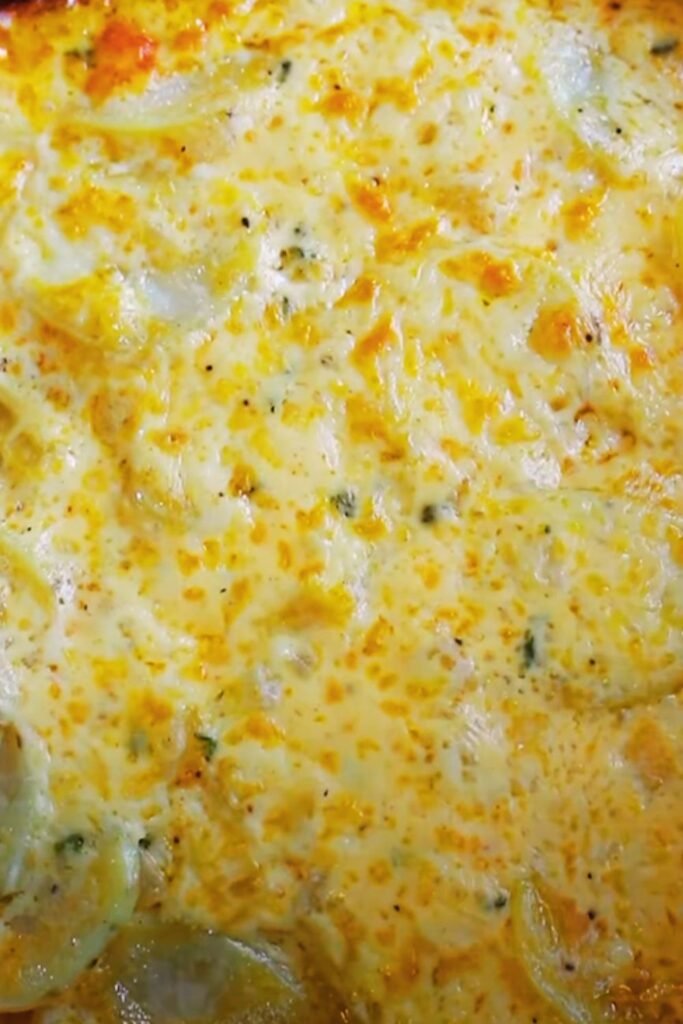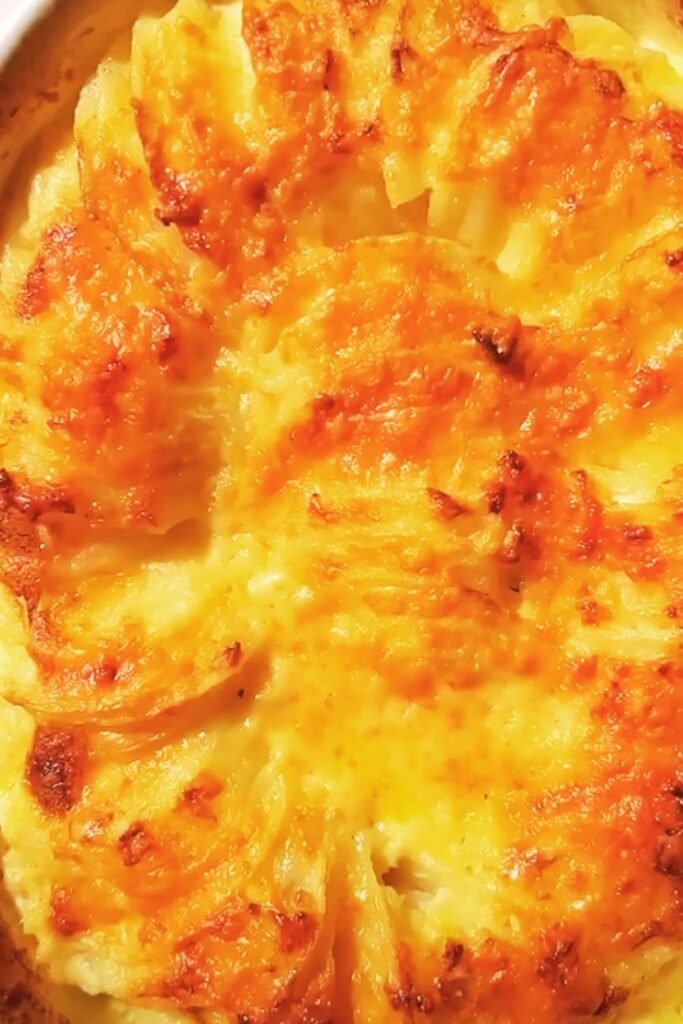There’s something magical about a dish of creamy, cheesy scalloped potatoes fresh from the oven. The golden-brown crust revealing layers of tender potatoes bathed in a rich, velvety sauce has the power to transport me straight back to my grandmother’s kitchen. Today, I’m sharing my perfected recipe for what I consider the ultimate comfort food – a dish that has graced countless holiday tables and family gatherings in my home.
The Secret to Perfect Scalloped Potatoes
Creating truly exceptional scalloped potatoes isn’t just about tossing some potatoes with cheese and cream. The magic lies in the details – from selecting the right potatoes to mastering the perfect consistency of the sauce. After years of trial and error (and yes, some memorable failures), I’ve discovered several key techniques that elevate this classic dish from good to absolutely unforgettable.
Choosing Your Potatoes
The foundation of great scalloped potatoes begins with selecting the right variety. I’ve experimented with numerous types over the years, and I’ve found that starchy or all-purpose potatoes work best for this dish:
- Russet potatoes – These higher-starch potatoes break down slightly during cooking, releasing their starch and helping to naturally thicken the creamy sauce. They absorb flavors beautifully.
- Yukon Gold potatoes – My personal favorite for this dish. Their buttery flavor and medium starch content create the perfect balance – they hold their shape while still contributing to a creamy texture.
- All-purpose potatoes – Varieties like white potatoes work well too, offering a middle ground between waxy and starchy options.
What you absolutely want to avoid are waxy potatoes like red potatoes or new potatoes. While wonderful in potato salads, they simply don’t absorb the cream sauce properly, resulting in a watery, less cohesive dish.
Essential Ingredients
Let’s talk about what goes into making truly spectacular scalloped potatoes. While the ingredient list isn’t long, each component plays a crucial role in building layers of flavor:
| Ingredient | Amount | Notes |
|---|---|---|
| Yukon Gold potatoes | 3 pounds (about 8 medium) | Sliced 1/8-inch thick for best results |
| Heavy cream | 2 cups | Creates the luxurious base for the sauce |
| Whole milk | 1 cup | Balances the richness of the cream |
| Fresh garlic | 4 cloves, minced | Infuses the cream with aromatic flavor |
| Fresh thyme | 2 teaspoons, finely chopped | Provides earthy, aromatic notes |
| Gruyère cheese | 1½ cups, freshly grated | Melts beautifully with a nutty flavor |
| Sharp cheddar | 1 cup, freshly grated | Adds color and tangy depth |
| Parmesan cheese | ½ cup, freshly grated | Creates the perfect crispy top |
| Yellow onion | 1 medium, thinly sliced | Adds sweetness and depth of flavor |
| Unsalted butter | 3 tablespoons | For sautéing and richness |
| All-purpose flour | 3 tablespoons | Helps thicken the sauce |
| Nutmeg | ¼ teaspoon, freshly grated | The secret ingredient that enhances the cheese flavor |
| Salt | 1½ teaspoons | Kosher salt preferred |
| Black pepper | ½ teaspoon, freshly ground | Adds subtle heat |
Equipment You’ll Need
Before diving into the cooking process, gather these kitchen tools to make your preparation smoother:
- Mandoline slicer – While not absolutely necessary, this tool ensures uniformly thin potato slices that cook evenly
- Large saucepan – For preparing the cream sauce
- 3-quart baking dish – Preferably ceramic or glass
- Sharp chef’s knife – For prepping ingredients
- Box grater – For freshly grated cheese (pre-shredded cheese doesn’t melt as well)
- Measuring cups and spoons – For accurate measurements

Preparation Method
I’ve learned that taking your time with each step of this recipe pays dividends in the final result. Here’s my detailed approach:
Step 1: Prep Work (20 minutes)
- Preheat your oven to 350°F (175°C) and position a rack in the middle.
- Butter your baking dish generously on the bottom and sides.
- Peel the potatoes and place them in a bowl of cold water to prevent browning.
- Using a mandoline or sharp knife, slice the potatoes into 1/8-inch thick rounds, returning them to the cold water as you work.
- Thinly slice the onion and mince the garlic.
- Grate all three cheeses and combine the Gruyère and cheddar in one bowl, keeping the Parmesan separate.
- Strip the thyme leaves from stems and chop finely.
Step 2: Make the Cream Sauce (15 minutes)
- In a large saucepan over medium heat, melt the butter until it begins to foam.
- Add the sliced onions and cook until softened and translucent, about 5-7 minutes.
- Add the minced garlic and cook for another 30 seconds until fragrant.
- Sprinkle the flour over the onion mixture and stir constantly for 1-2 minutes to cook out the raw flour taste.
- Gradually whisk in the heavy cream and milk, ensuring no lumps form.
- Add the thyme, salt, pepper, and nutmeg to the sauce.
- Bring the mixture to a gentle simmer, stirring frequently, and cook until it thickens slightly (about 5 minutes).
- Remove from heat and stir in 1 cup of the combined Gruyère and cheddar until melted.
Step 3: Assembly (10 minutes)
- Drain the potato slices thoroughly and pat dry with paper towels.
- Place a single layer of potato slices in the bottom of the prepared baking dish, slightly overlapping them.
- Pour about 1/4 of the cream sauce over the potatoes.
- Sprinkle with a portion of the remaining Gruyère-cheddar cheese mixture.
- Repeat the layers (potatoes, sauce, cheese) until all ingredients are used, ending with a layer of sauce.
- Reserve the last portion of the cheese mixture and all of the Parmesan for the topping.
Step 4: Baking (75-90 minutes)
- Cover the dish tightly with aluminum foil.
- Bake for 45 minutes.
- Remove the foil and sprinkle the remaining Gruyère-cheddar mixture and all of the Parmesan evenly over the top.
- Return to the oven, uncovered, and bake for an additional 30-45 minutes until deeply golden brown on top and the potatoes are completely tender when pierced with a knife.
- Allow the dish to rest for 15-20 minutes before serving. This crucial resting period allows the sauce to thicken and the flavors to settle.

The Science Behind Perfect Scalloped Potatoes
I find the culinary science behind this dish fascinating. Several key processes occur during preparation that contribute to the final texture and flavor:
Starch Gelatinization
The starch in the potatoes gelatinizes during cooking, absorbing the liquid and creating that wonderful creamy texture. This is why slicing the potatoes thinly is so important – it allows for more complete gelatinization.
The Maillard Reaction
The beautiful golden-brown crust forms due to the Maillard reaction – a chemical reaction between amino acids and reducing sugars that gives browned foods their distinctive flavor. This is why uncovering the dish for the final baking period is so essential.
Sauce Stabilization
The flour in the sauce creates a roux with the butter, which stabilizes the emulsion of fat from the cheese and cream. This prevents the sauce from breaking or becoming greasy during the long baking time.
Variations to Explore
While I consider this recipe the gold standard for classic scalloped potatoes, I’ve developed several variations over the years that are worth trying:
Herb Variations
- Rosemary & Sage – Replace the thyme with 1 tablespoon fresh rosemary and 1 tablespoon fresh sage for a more robust herb flavor
- Herbes de Provence – Add 1 teaspoon of this herb blend for a French countryside flavor
- Dill & Lemon – Add 2 tablespoons fresh dill and 1 teaspoon lemon zest for a brighter, Scandinavian-inspired version
Cheese Combinations
| Style | Main Cheese | Secondary Cheese | Unique Addition |
|---|---|---|---|
| Italian | Fontina (1½ cups) | Pecorino Romano (½ cup) | 1 tsp Italian herbs |
| Swiss | Emmental (1½ cups) | Appenzeller (1 cup) | Pinch of nutmeg |
| American | Extra sharp cheddar (2 cups) | Monterey Jack (½ cup) | 1 tsp mustard powder |
| French | Comté (1½ cups) | Reblochon (1 cup) | 1 tbsp cognac in cream |
Add-Ins for Heartier Variations
While purists might disagree, these additions can transform scalloped potatoes into a complete meal:
- Protein options: Layering in 8 oz of diced ham, 6 slices of crumbled bacon, or 2 cups of shredded rotisserie chicken
- Vegetable additions: Including 2 cups of sautéed mushrooms, 1 cup of roasted red peppers, or 2 cups of blanched broccoli florets between layers

Common Mistakes to Avoid
Through years of making this dish, I’ve encountered (and made) every possible mistake. Here are the pitfalls to avoid:
- Using pre-shredded cheese: These contain anti-caking agents that prevent proper melting. Always grate your cheese fresh.
- Skipping the resting period: Serving immediately from the oven results in a runny sauce that hasn’t had time to set up.
- Uneven potato slices: Varied thickness leads to some potatoes overcooking while others remain undercooked.
- Under-seasoning: Potatoes need plenty of salt to shine. Taste your cream sauce before assembly.
- Rushing the sauce: A properly thickened sauce is the foundation of this dish. Take your time developing it.
- Using low-fat dairy: This dish relies on the fat content in cream and whole milk. Lower-fat substitutions lead to a watery, less flavorful result.
Make-Ahead and Storage Tips
One of the things I love about this dish is how well it fits into meal planning. Here’s how I handle make-ahead preparation and storage:
Make-Ahead Options
Prepare a day ahead: Assemble the entire dish, cover tightly with foil, and refrigerate. When ready to bake, let it sit at room temperature for 30 minutes, then follow the baking instructions, adding an extra 15 minutes to the covered baking time.
Partially bake ahead: Cover and bake for 30 minutes, then cool completely, wrap tightly, and refrigerate. When ready to serve, bake covered for 30 minutes at 350°F, then uncover, add the remaining cheese topping, and bake for 30-45 minutes until golden and bubbly.
Storage and Reheating
Refrigeration: Leftovers can be covered and refrigerated for up to 4 days.
Reheating:
- Individual portions: Microwave on 50% power for 2-3 minutes
- Whole dish: Cover with foil and bake at 325°F for 20-30 minutes until heated through
Freezing: While possible, I don’t recommend freezing this dish as the cream sauce can separate and the potatoes may become mealy upon thawing. If you must freeze it:
- Cool completely
- Wrap tightly in plastic wrap, then aluminum foil
- Freeze for up to 2 months
- Thaw completely in refrigerator before reheating
Serving Suggestions
Scalloped potatoes pair beautifully with many main dishes. Here are my favorite ways to serve them:
- With roasted meats: The perfect side for a holiday ham, prime rib, or roast chicken
- Alongside vegetables: Balance the richness with roasted Brussels sprouts, asparagus, or a crisp green salad with vinaigrette
- As the star: Serve as a main dish with a simple green salad for a comforting vegetarian meal
- Brunch option: They make an excellent side dish for a special brunch, paired with eggs and fresh fruit
Nutrition Information
While this is decidedly a special occasion dish, it’s helpful to understand the nutritional content. Here’s a breakdown per serving (based on 10 servings):
| Nutrient | Amount per Serving |
|---|---|
| Calories | 385 |
| Total Fat | 25g |
| Saturated Fat | 15g |
| Cholesterol | 85mg |
| Sodium | 520mg |
| Total Carbohydrates | 30g |
| Dietary Fiber | 3g |
| Protein | 12g |
| Calcium | 350mg |
| Potassium | 720mg |
Questions & Answers
How thick should I slice the potatoes? Aim for 1/8-inch thickness, which is about the thickness of two quarters stacked together. This ensures the potatoes cook through while maintaining their structure. A mandoline slicer makes this task much easier and more consistent, but a sharp knife works well too.
Why did my sauce curdle? Curdling typically happens when the dairy is heated too quickly or to too high a temperature. Make sure you’re using full-fat dairy products, add them gradually to the roux while whisking constantly, and maintain a gentle simmer rather than a boil.
Can I make this dish lighter or lower in calories? While traditional scalloped potatoes are inherently rich, you can make a lighter version by replacing half the cream with chicken broth and reducing the cheese by about a third. The result won’t have quite the same luxurious texture but will still be delicious.
My potatoes are still crunchy after the full cooking time. What went wrong? This usually happens when the potato slices are too thick or the dish is piled too high. Make sure your slices are consistently thin and your baking dish isn’t overcrowded. If needed, cover the dish again with foil and continue baking until the potatoes are tender.
Can I use different types of cheese? Absolutely! The cheese combination can be customized to your taste. Just make sure to include at least one good melting cheese (like Gruyère, fontina, or Monterey Jack) as your base, and complement it with something more flavorful. Avoid cheeses that are very dry or don’t melt well.
Why do you recommend freshly grated cheese instead of pre-shredded? Pre-shredded cheeses contain anti-caking agents that prevent them from clumping in the package, but these same additives also interfere with proper melting. They create a grainy texture rather than the smooth, creamy consistency we want.
Do I need to peel the potatoes? While I prefer peeled potatoes for the smoothest texture, you can leave the skins on if you prefer. Just make sure to wash them thoroughly and consider using a potato variety with thinner skin, like Yukon Gold, rather than thick-skinned Russets.
How do I know when the dish is done? The top should be deeply golden brown, and when you insert a knife into the center, it should slide through the potatoes without any resistance. If there’s any crunch or firmness, continue baking.
There’s something deeply satisfying about perfecting a classic comfort food like scalloped potatoes. This dish may take a bit of time and attention, but the results are so worth it. Whether for a holiday gathering or a special Sunday dinner, these creamy, cheesy layers of potato goodness never fail to bring smiles to the table. I hope you enjoy making and sharing this recipe as much as I do!